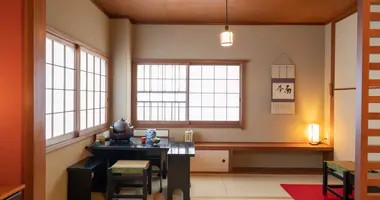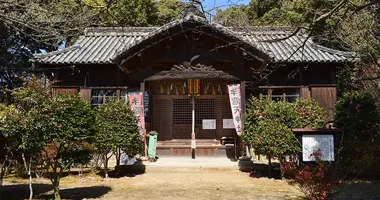Saijo Inari Okayama
- Published on : 23/03/2014
- by : Japan Experience
- Youtube
Saijo Inari in Okayama Prefecture is one of the Top Three Inari shrines/temples in Japan along with Fushimi Inari in Kyoto and Toyokawa Inari in Aichi.
Saijo Inari 最上稲荷山妙教寺
Jake Davies
In Japan almost everything is ranked and graded, and a common system is to categorize things as the "Top Three", common ones being the Three Most Beautiful Views, the Three Most Beautiful Gardens, the Three Most Famous Hot Springs, etc, so it will come as no surprise to find the Three Great Inari Shrines.
Inari shrines are the most common of all shrines throughout Japan. Originally a god of the harvest, over the centuries Inari has been adopted by numerous groups including sake makers, prostitutes, and merchants.
Many modern businesses will have their own private Inari shrines, sometimes found on the roof of high-rise head offices. Often erroneously called a Fox God, Inari's messengers are foxes which is why pairs of fox statues can usually be found guarding the entrance to Inari shrines.
 Saijo Inari torii, Okayama Prefecture, Japan
Saijo Inari torii, Okayama Prefecture, Japan  Fox Statue, Saijo Inari
Fox Statue, Saijo Inari
Top Three Inari Shrines
The number one Inari shrine is the famous Fushimi Inari just south of Kyoto, believed to be the original Inari shrine. The number two Inari shrine is almost always listed as the Toyokawa Inari in Aichi Prefecture, but the number three Inari shrine will vary depending on which part of the country you happen to be, but in areas around Okayama it is Saijo Inari.
The approach road is straddled by a huge torii, 28 meters high. Its the fourth tallest torii in Japan, taller than either the one at Heian Jingu in Kyoto or Yasukuni Shrine in Tokyo, both of which are often cited as being the tallest in Japan.
From the parking lot you run the gauntlet of vendors on either side of a narrow, covered, lane lined with shops selling all manner of drinks, sweets, ice creams, and of course cheap gifts and souvenirs, until you arrive at the main gate to the temple, and here you come across a surprise.
Normally the Niomon, the gate housing a pair of fierce-looking protectors, will be made of wood, or sometimes concrete in the style of wood, but here the gate is made of stone and in the style of an Indian palace. Through the gate and up the banner-lined steps and you are now in front of the large, imposing main hall. It looks like a Buddhist temple, but strung across the entrance is a large shimenawa, the sacred rope one normally associates with Shinto shrines. Which is it, a shrine or a temple?
 Stone cliff carved and sculpted into curved and wave-like forms resembling turbulent water, Saijo Inari, Okayama Prefecture
Stone cliff carved and sculpted into curved and wave-like forms resembling turbulent water, Saijo Inari, Okayama Prefecture
History of Saijo Inari
Saijo Inari was founded, according to the legend, by a monk named Ho-on Daishi in the 8th century. It was later made into a Tendai temple named Myokyo-ji. Later it changed sects and became a Nichiren temple in the 16th century.
In 1954 it separated from the Nichiren sect and founded its own religious organization, the Saijo Inarikyo, of which it is the head temple, so, the simple answer to the question of whether it is a shrine or a temple is, yes!
Along with Inari, the temple/shrine places great emphasis on the Lotus Sutra, and if you look behind the main hall you will see something quite unusual. The stone cliff has been carved and sculpted into curved and wave-like forms that resemble turbulent water. In some way this relates to the Lotus Sutra.
The real delights of Saijo Inari begin when you pass through the torii that stands at the base of the hillside to the right of the main hall. A series of paths wind around the hillside past dozens and dozens of small Inari shrines set in the forest.
Here you can see a wide variety of fox statues, most made of stone, a few, almost abstract ones, of concrete, and some finely detailed ones made of local ceramics. Why so many shrines to one kami? Well, they are all different manifestations, each shrine will be to an aspect of Inari that believers have set up to pray to for different things.
Traditionally it was not to a universal kami or buddha that people prayed to, rather to a specific, localized one. Those that gained a reputation for successful answers to specific prayers would become more famous and their shrine would grow. This is why at the bigger Inari shrines like Fushimi, Yutoku, or here at Saijo, there are so many small shrines.
 Indian-style Niomon, Saijo Inari, Okayama Prefecture
Indian-style Niomon, Saijo Inari, Okayama Prefecture Saijo Inari Main Hall, Okayama
Saijo Inari Main Hall, Okayama
Access - Getting to Saijo Inari
Saijo Inari
712 Takamatsuinari
Kita-ku
Okayama 701-1331
Tel: 086 287 3700
Saijo Inari is north west of Okayama city on National Highway 180 and just off National Highway 241.
The nearest station is Bitchutakamatsu on the Kibi Line, which is 5 minutes away by taxi. There are buses from JR Okayama Station taking about 30-45 minutes (610 yen).
If traveling by car, Saijo Inari can be combined with a visit to Iyama Hofuku-ji.
Read more about Shinto religion
















